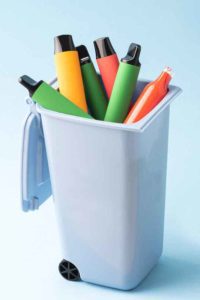Unfit for the Counter
- Also in TR Illicit Trade
- April 25, 2023
- 0
- 8 minutes read

Unwrapping the issue of counterfeit and noncompliant vapes
By Lee Bryan

It feels as though you can’t check the news these days without reading about rogue traders dishing out vapes to kids or stumbling across the latest report about Trading Standards—the U.K. authority charged with enforcing consumer protection legislation—seizing a few thousand counterfeit devices.
National newspaper headlines about youth vaping and environmental damage have changed public perceptions on the reduced-risk product, and evidence shows that many people wrongly believe vapes are equally or more harmful than cigarettes, leading some smokers to decide against making the switch.
The U.K. government has historically been pro-vaping, taking an evidence-based approach and encouraging smokers to switch as part of its smoke-free 2030 ambitions. However, a minority within the industry who flout the law and put their profits above all else are putting all of this at risk for the sake of their own greed.
The vape sector is primarily a community of well-intentioned retailers, manufacturers, distributors and activists whose main priority is to help adult smokers move away from combustible tobacco, and as the head of a leading vape compliance firm, I’ve seen this firsthand.
The unscrupulous sellers, who provide so much ammunition to the mainstream media, are as much at odds with the rest of the harm reduction community as they are with regulators and health officials. They must be stopped before they take vaping from being one of the most popular and effective stop smoking tools available in the U.K. to public enemy No. 1.
Where Are Brands Falling Short?
As a leading authority on vape regulations, we at Arcus Compliance understand how complex the road to a compliant status can actually be and recognize the challenges of meeting legal obligations.
Even those with the best intentions can fall foul of regulations if they don’t have the right knowledge, and our job is to help them navigate this often difficult terrain.
In fact, we conducted an industry-wide analysis that uncovered the most common ways that vaping products fall short of regulatory requirements. These included:
- inadequate checks to ensure e-liquid recipes do not contain inappropriate substances in specific markets;
- copying competitors’ labeling;
- notifying the wrong product type to the regulator;
- reusing former identifier codes for new products; and
- lacking systems for tracking adverse safety events.
In many cases, these can be put down as simple mistakes, but errors like these can make the regulatory process more expensive and complicated for brands.
They can also bring a product’s journey to approval to a grinding halt and land it in hot water with the Medicines and Healthcare products Regulatory Agency (MHRA), the body responsible for overseeing the U.K. market.
It’s critical that brands avoid these common pitfalls and ensure their vape products are up to standard across the board, especially when tensions over industry compliance are so high.
Wholesalers and retailers must also step up and play a role here by demanding only the highest levels of compliance from products and brands, not only to protect their own reputations but also the reputation of the entire sector.
Recognizing the need for further regulatory support in the industry, Arcus Compliance recently teamed up with distributor Phoenix 2 Retail to deliver a “Pre 2 Post-Market Compliance Testing Program.”
This collaborative effort aims to support and maintain industry standards while also encouraging the evolution of policies that raise the bar when it comes to responsibility.
Sadly, there’s no denying that a small pool of traders are knowingly going against the law to line their own pockets—typically by selling to minors or pedaling youth-appealing products.
They cast a dark cloud over our industry and deserve to feel the full force of the law, which is why I welcome the recent comments of Neil O’Brien, the parliamentary under-secretary of state at the Department of Health and Social Care, to clamp down on regulatory noncompliance, set up a Trading Standards “flying squad” to enforce the rules and tackle illicit vapes and underage sales and to set up a national test purchasing scheme—something for which the U.K. Vaping Industry Association has long been advocating.
Policies like these represent a significant forward step in combatting the noncompliant sector, and I’m confident that they can be the foundation on which we can level up accountability and responsibility in the U.K. vaping arena.
By coming down hard on those who flout the law, policymakers can protect young people, prevent underage sales and allow the compliant vape industry to thrive.
Where Does Policy Need to Go From Here?
While the government’s renewed determination to stop rogue traders and prevent youth access is wholly welcome, we can’t allow ourselves or our politicians to make the mistake of thinking the problem is now solved—the reality is that we are a long way from the finish line.
If nothing else, lawmakers should take onboard other recommendations put forward by the UKVIA, including increased fines of up to £10,000 ($12,409) per instance for those caught selling to minors and a retail registration scheme.
It’s also high time we reviewed the arbitrary limit on e-liquid volume for vapes. If we were to increase this from the current legal maximum of 2 mL to a more substantial 10 mL, we could make e-cigarettes far too expensive for young people to buy while ensuring vapes remain competitively priced against cigarettes.
More urgently, regulators need to tighten their grip around product and packaging by introducing more checks during the market approval process.
It still amazes me that brands don’t have to upload any pictures to the MHRA when they apply for permission to sell in the U.K., and making this one, relatively small, adjustment could make a big difference to the compliance issue by preventing products with child-appealing imagery—i.e., cartoon characters and copycat candy designs—from ever making it onto the shelves.
Preemptive strategies like this will help wash away vapes that are blatantly trying to catch the attention of kids, reaffirm the industry as adult-focused and could prove to be an invaluable tool in the fight to eliminate youth use and underage access.
The government must now build on the new momentum brought forth by its newly announced measures by engaging in conversation with industry experts and implementing balanced policies that target the illegal market while supporting vaping as a public health tool.
Regulators, retailers, health officials and advocates together are perfectly positioned to pioneer a new age of vape compliance—I only hope we can seize this critical opportunity.

